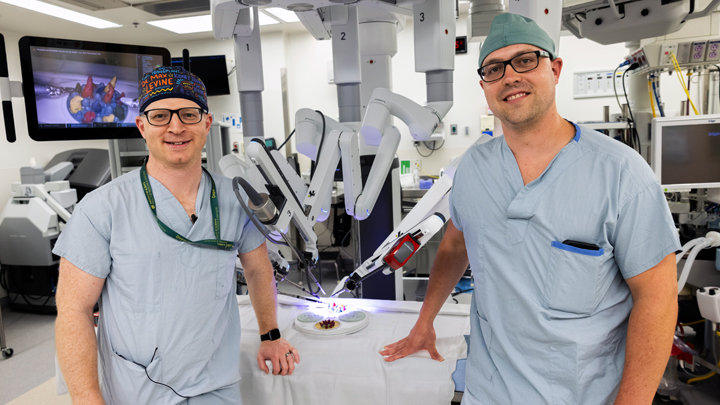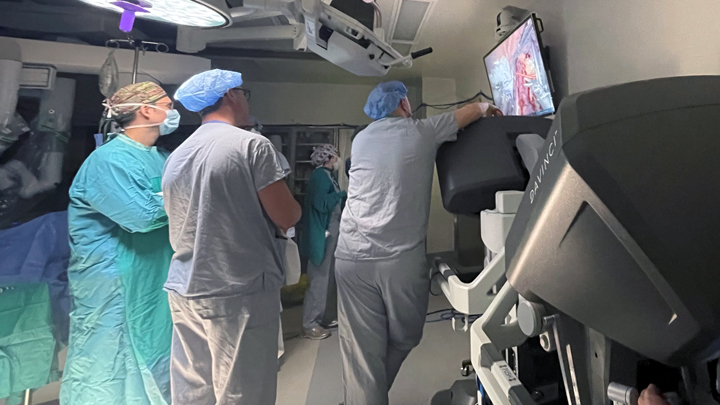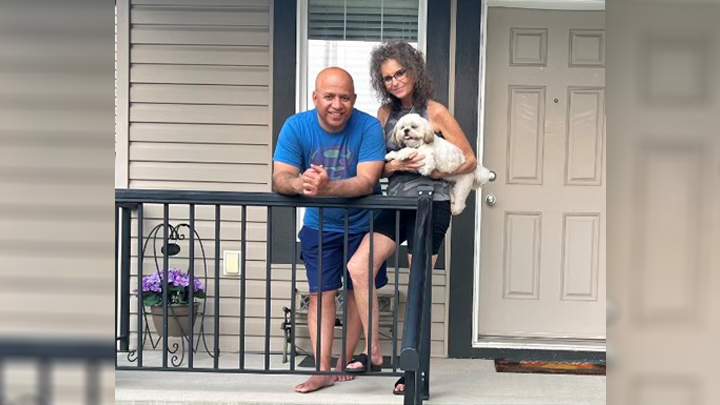
August 15, 2024

Dr. Max Levine, surgical director of the University of Alberta Hospital Kidney Transplant Program, and Ryan Amyotte, team leader of the UAH Urology Service, stand next to the da Vinci Robotic Surgical System. Photo by Evan Isbister.

Dr. Max Levine controls robotic arms from a console as his University of Alberta Hospital team — Dr. Andrew Rasmussen, left, Dr. Blair St. Martin and Dr. Trevor Schuler — watch the procedure unfold. Photo courtesy of Dr. Max Levine.

Kidney recipient Carmen Newchuk and Ernie Peters are looking forward to a vacation, after finishing years of her dialysis treatments. Photo courtesy of Carmen Newchuk.
Story by Su-Ling Goh | Photo & video by Evan Isbister
EDMONTON — Alberta Health Services’ Dr. Max Levine has performed Canada’s first robot-assisted kidney transplant. This minimally invasive technique involves smaller incisions and faster recovery, opening the door for patients who might not otherwise be suitable candidates for transplant surgery.
“The benefits relate to what we don’t have to do to the patient,” says Levine, the Surgical Director of the University of Alberta Hospital’s (UAH) Kidney Transplant Program.
“We don’t have to make a big incision and we don’t have to put a large retractor in (the incision) to expose things. So post-operative pain is better in these patients. Their risk of wound infection, wound breakdown and complications — in terms of fluid collection around the kidney — are all improved when compared to the open (surgery) approach.”
Levine trained in Belgium in November 2023, learning to apply a robotic surgical platform to transplant surgery by precisely controlling robotic arms from a large arcade-game-like console. In June, he used the UAH’s existing da Vinci Xi Robotic Surgical System, with a few new parts, to perform the historic procedure.
“It’s a totally different way to operate. You don’t have the same tactile sensation, but you have greater spatial awareness than you do with other minimally invasive approaches,” says Levine.
Avoiding the need for a large incision means the robotic technique can be safely used for patients with an increased risk of complications, such as those with a higher body mass index.
To start with, Levine chose two lower-risk patients. The first was Amy Dubyk, who needed her left kidney moved to her right side due to Nutcracker syndrome, a rare and painful vein compression disorder.
“I have seven incisions, just small half-an-inch wide incisions,” says Dubyk, who became the first robot-assisted autotransplant (transplanting organs or tissues to another part of a person’s body) patient in western Canada.
“Without (robot-assisted surgery), I would have had a long, big incision. It would have been a much more difficult healing process and recovery.” Levine’s second patient, Canada’s first robot-assisted kidney transplant, was Carmen Newchuk. Her husband, Ernie Peters, donated one of his kidneys to her.
In 2022, Newchuk was diagnosed with kidney failure due to a rare genetic condition, thrombotic microangiopathy (a condition where the kidney dies because of damaged blood vessels). Over two years, she received dialysis in hospital several times a week; 304 treatments in total. When it came time for a transplant, her husband stepped up for testing to donate.
“It’s quite surreal for us,” she says. “We’re still a little bit in shock that we’re a match, because it’s not only a blood match, but our cells and tissues had to match, and it worked out,” she adds with a smile.
“We’re very ecstatic,” says Peters. “We were hoping (for a match) … it was a long shot.”
Peters had traditional laparoscopic surgery, while Newchuk had the robotic procedure. She says when Levine presented the option to her, she jumped at the opportunity.
“(Levine) gave us time to think about it, but I gave him my answer right there. There were so many advantages to (robotic surgery),” says Newchuk. “All my incisions have healed really nicely. (With) the five-centimetre incision, you can’t even tell I had surgery there.”
The two successful cases officially launch Edmonton’s Robotic Renal Transplant Program, with the next cases likely in the fall. Levine is grateful to his UAH team for their support.
Newchuk is also thankful, especially for her husband’s selfless donation.
“I didn’t think he was going to come into my life to save my life,” says a teary Newchuk. “And I’m so grateful … so grateful.”
For more information on organ and tissue donation, visit www.GiveLifeAlberta.ca.